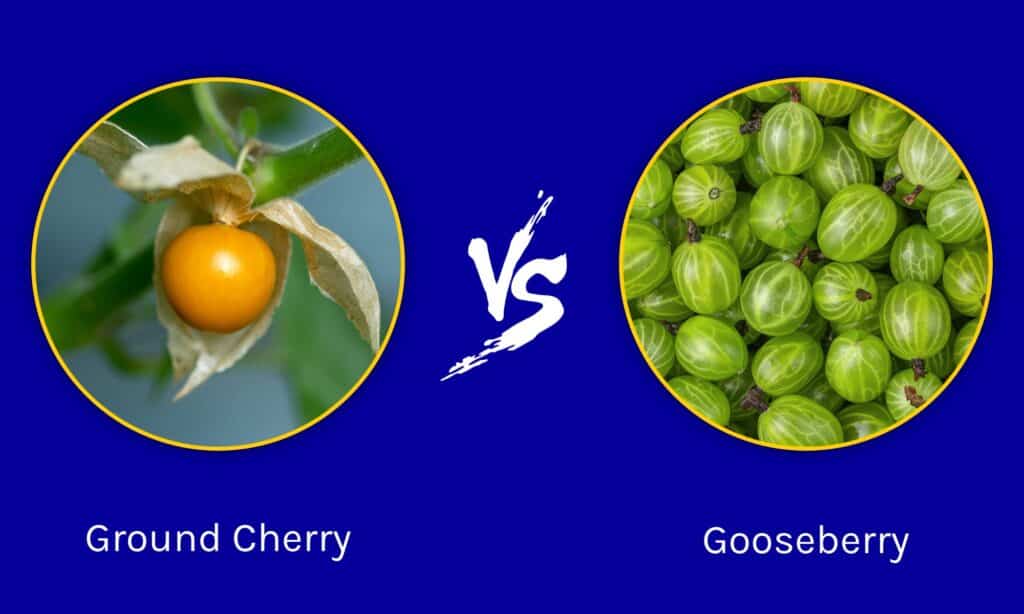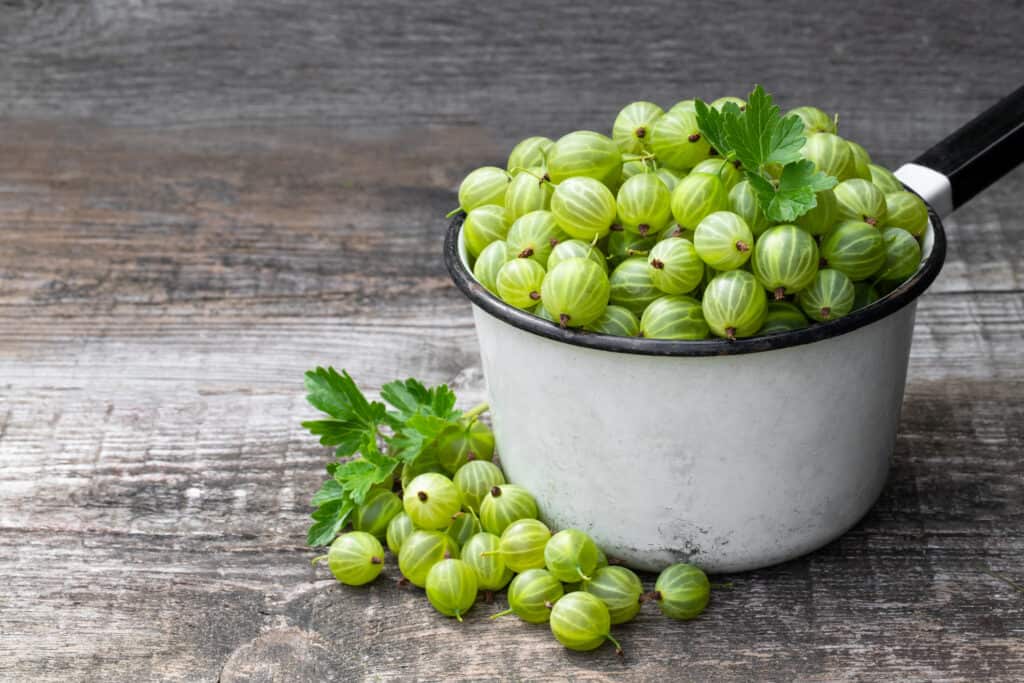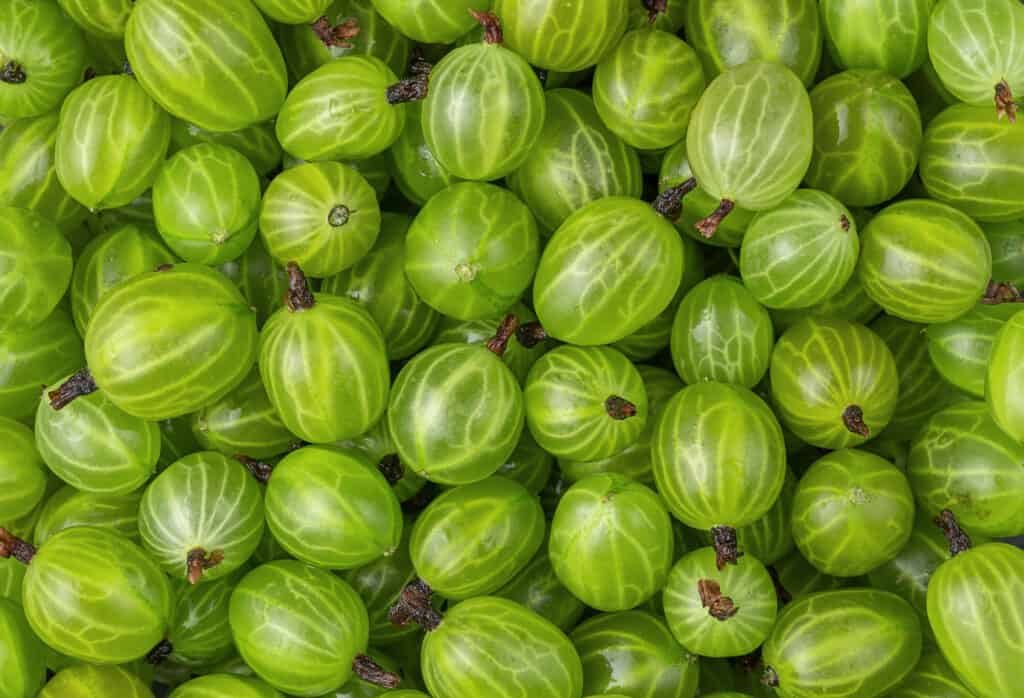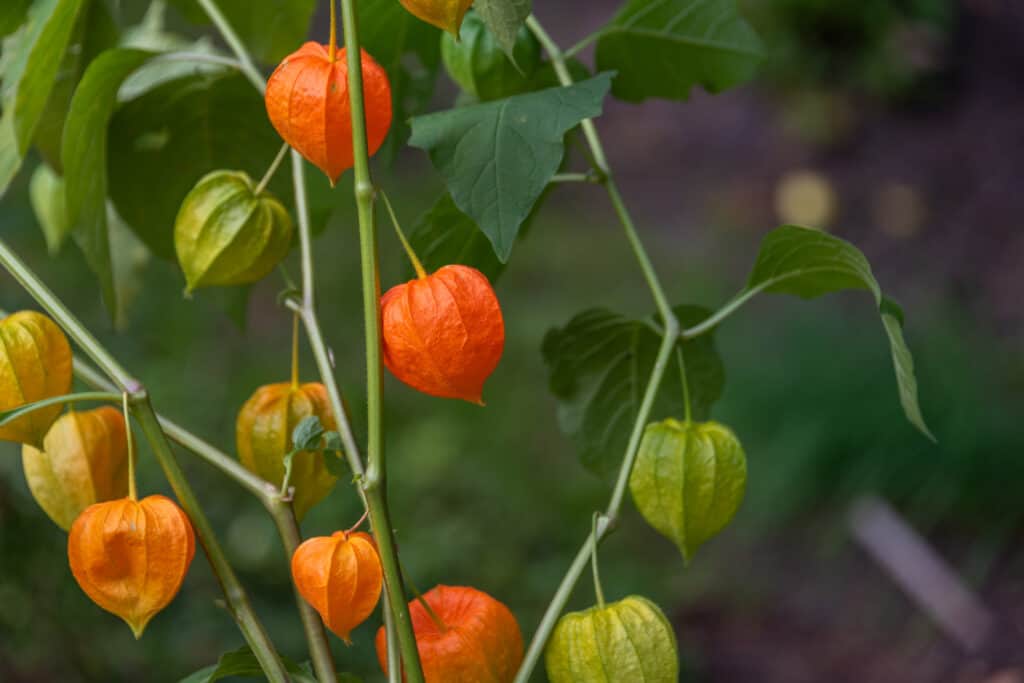There are over 400 species of cherries in the Rosaceae family, but ground cherries are not one of them. Ground cherry is not a real cherry. In fact, it belongs to the Physalis genus in the Solanaceae family, which means they are more related to potatoes and tomatoes. Gooseberries, on the other hand, belong to the Ribes genus in the Grossulariaceae family.
So what are the differences between ground cherries and gooseberries? Can humans eat these plants? How can we tell them apart? Before comparing these two, it’s important to note that “gooseberry” refers to many of the 200 species in the Ribes genus. However, today, we’ll only focus on the Ribes hirtellum species. Here is a detailed comparison of their classification and anatomy.
Comparing Ground Cherry vs. Gooseberry

| Ground Cherry | Gooseberry | |
|---|---|---|
| Classification | Kingdom: Plantae Clade: Tracheophytes Clade: Angiosperms Clade: Eudicots Clade: Asterids Order: Solanales Family: Solanaceae Genus: Physalis Species: Physalis longifolia | Kingdom: Plantae Clade: Tracheophytes Clade: Angiosperms Clade: Eudicots Order: Saxifragales Family: Grossulariaceae Genus: Ribes Species: Ribes hirtellum |
| Origin | North America | Northeastern and north-central United States, Canada |
| Plant Type | Edible fruit, Poisonous (any other plant part), Perennial, Shrub | Edible, Nonpoisonous, Perennial, Shrub |
| Size | Plant Height: About 2 ft (24 in) | Plant Height: Up to 4 ft (48 in) |
| Habitat | Disturbed areas, forests or thin woodlands, and sandy, open areas | Terrestrial, wetlands |
| Flower color | Pale yellow or lemon yellow | Greenish-white to pink |
| Flower Description | – Flowers grow in the leaf axils – The flower has five petals with bluish or purplish streaks at the base | A cluster of 1 to 3 stalked bell-shaped flowers that grow from the leaf axis, five greenish-white petals with purple spots around the edges |
| Leaf description | 1.5 to 2.7 in (4 to 7 cm), petioled, irregularly toothed | 1 to 2.5 inches (2.5 to 6 cm) long leaves with hairy stems |
| Fruit Description | Size: Up to half an inch (1 to 1.2 cm) in diameter The unripe fruit color is green The ripe fruit color is yellow | Size: ¼ to ⅓ inch (0.6 to 0.8 cm) in diameter Ripe color: Greenish to purple |
| Toxicity | Flowers, unripe fruits, leaves, and stems are poisonous. All parts are severely toxic to humans except the ripe (yellow) fruits | Not poisonous to humans but can be harmful to geese, and chicken |
| Poisonous Content | Solanine and other solanidine alkaloids | None |
The Key Differences Between Ground Cherry vs. Gooseberry
Ground cherries and gooseberries have major distinctions in their taxonomic classification, flowers, fruits, and toxicity.
Are you trying to decide which one will fit your garden and lifestyle? Here are four key differences between ground cherry vs. gooseberry.
Ground Cherry vs. Gooseberry: Classification

The term gooseberry refers to all species in the
Ribesgenus.
©iStock.com/Lena_Zajchikova
Ground cherries are perennial herbs, and according to records, there are about 30 ground cherry species in the US. The term ground cherry applies to many species from a genus called Physalis, which belongs to the Solanaceae (nightshade) family. Tomatoes, potatoes, eggplant, and peppers belong to the Solanaceae family. However, this family has several poisonous and even deadly species, so assessing all their characteristics is important.
The term gooseberry refers to all species in the Ribes genus. Ribes is the only genus of the Grossulariaceae family of deciduous shrubs. According to studies, there are over 160 Ribes species worldwide, and most of them are gooseberries, black currants, and red currants. However, there are two major types of commercially-produced gooseberry plants: the American gooseberry (Ribes hirtellum) and the European gooseberry (Ribes uva-crispa). They are sometimes mistaken for one another.
Ground Cherry vs. Gooseberry: Flowers
The flowers of ground cherries range from pale yellow to lemon yellow. Flowers grow on the leaf axis, the area along shoots where leaves grow. Each flower has yellow petals with bluish or purplish spots in the middle, merging and forming a ring. The flowers of ground cherries are toxic to humans. Common gooseberry or hairy-stemmed gooseberry flowers vary from greenish-white to pink. Gooseberries have hairy stems with thinly distributed pricks, but their flowers and fruits are hairless.
Ground Cherry vs. Gooseberry: Fruits

Gooseberry fruits are greenish-purple and taste similar to grapes.
©iStock.com/Serhii Tychynskyi
According to studies, ground cherries have fleshy fruits that are about half an inch (1 to 1.2 cm) in diameter and grow inside a husk. Immature or unripe ground cherry fruits are green. Ripe fruits are yellow and look like small tomatoes with an inflated calyx.
Gooseberries also have fleshy fruits about ¼ to ⅓ inch (0.6 to 0.8 cm) in diameter. Their fruits are greenish-purple and taste similar to grapes. Their outer layer is translucent. Sources show that the fruits of American cultivars are smaller but healthier than those of European cultivars. However, European cultivars are more flavorful.
Ground Cherry vs. Gooseberry: Effect on Humans

Only the ripe fruits of ground cherry plants are edible.
©iStock.com/Andrey Nikitin
The fruits of gooseberries are edible and not poisonous, even when unripe. However, many people prefer to eat ripe fruits because of their taste.
On the other hand, ground cherries may look like small tomatoes, but they are highly poisonous. The flowers, stems, and unripe fruits contain solanine and other solanidine alkaloids, which are harmful to humans when consumed. Once ingested, you may show symptoms like headache, stomach pain, lowered temperature, dilated pupils, vomiting, and diarrhea. It may also lead to more severe symptoms such as circulatory and respiratory depression and loss of sensation, and in some cases, it can be fatal. Only the ripe fruits of ground cherry plants are edible. To make sure the fruit is ripe, you should check its color. The fruit should be completely yellow. Make sure that spots or streaks are not visible. You must contact a doctor immediately if you ingest an unripe ground cherry.
Up Next:
- Grape Tomato vs. Cherry Tomato: Is There a Difference?
- Use Extreme Caution If Dogs Eat Cherries! Here’s Why
- Skip Laurel vs. Cherry Laurel: Is There a Difference?
The photo featured at the top of this post is © iStock.com/Serhii Tychynskyi
Sources
- NC State University Extension, Available here: https://plants.ces.ncsu.edu/plants/physalis/
- Missouri Department of Conservation, Available here: https://mdc.mo.gov/discover-nature/field-guide/common-ground-cherry
- Lady Bird Johnson Wildflower Center, Available here: https://www.wildflower.org/plants/result.php?id_plant=RIHI
- AgMRC, Available here: https://www.agmrc.org/commodities-products/fruits/gooseberry
Thank you for reading! Have some feedback for us? Contact the AZ Animals editorial team.






